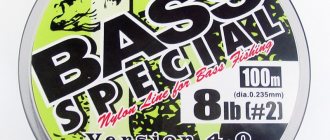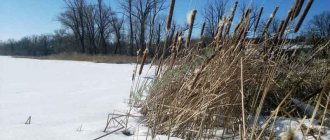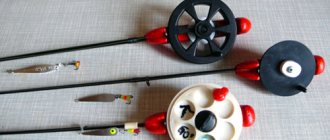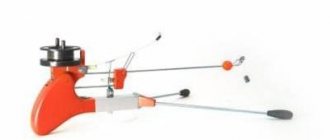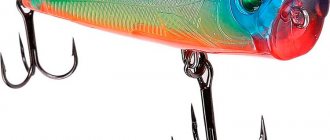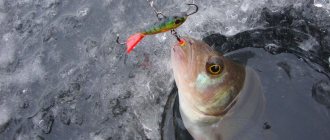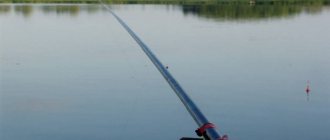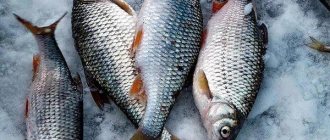Fishing rods for winter fishing for perch and their features
The winter fishing rod for perch is one of the most diverse types of fishing rods. This is because perch is a very popular fish species that easily gets into a fisherman’s backpack in winter. It is difficult to name another fish that bites well on both live and artificial bait. Accordingly, the equipment for this picky predator is very diverse.
Humpback (the common name for perch) is hooked both at the beginning of winter and at its end. In winter, the predator develops a special appetite. In order to have an excellent catch, a winter fishing rod for perch must be assembled and adjusted in accordance with seasonal characteristics.
In various conditions, avid fishermen use the following types of gear:
- A fishing rod with an attached jig. The most common fishing tackle. In addition to perch, almost all types of fish can be caught with it. We can say with confidence that if a fisherman gets on the ice with such a fishing rod, then he will definitely not return without catch. It consists of a fishing rod (fishing rod handle) with a device for fishing line, a short whip (10-20 cm) and a nod for signaling a bite. The thickness of the line reaches from 0.06 to 0.14 mm. The bait is bloodworms.
- Mothless. This name is given to a light fishing rod, intended mainly for sport fishing for active perch. Its composition is the same as that of the tackle with a nozzle, only the fishing rod is lighter, for a long, long game with fish. Often, amateur fishermen make such a fishing rod for themselves.
- Lightweight fishing rod. Lightweight compact spinners are used for artificial baits, for example, small balancers, small fish made of silicone, miniature vertical spinners, amphipods. The length of the whip is usually 30-40 cm. Due to the inability to clearly grasp the process of fish biting, the fishing rod is equipped with a nod. There may or may not be a reel in this type of gear. A characteristic difference is the short fishing rod. The fishing line used is your choice: monofilament, with a monofilament diameter of 0.16-22 mm, or braided line - 0.08 - 0.12 mm.
- Heavy fishing rod for trolling. Designed for fishing, the purpose of which is large species of perch and pike. Strict requirements are imposed on such gear, since the fishing line has to be equipped with a heavy spoon or large balancers. The thickness of the fishing line is 0.20-0.28 mm for monofilament, and 0.14-0.18 for braided line. The basis of this type is a long and strong fishing rod, the length range of which is 50-70 centimeters. For such a fishing rod you need a powerful reel that not only stores the fishing line, but also helps to pull large prey out of the hole. The reel's braking system must be perfectly tuned and should not fail at the most crucial moment.
- Zherlitsa. This is the name of a winter fishing rod for perch, or any other predator that bites on live bait. The bait for humpback fish is slightly different from the classic one designed for catching pike. This is due to the fact that perch is an active fish; it does not need to sit for a long time and wait for a predator to swallow the bait. It is necessary to pull out the rod as soon as the flag twitches. And the size of the tackle for perch is a little smaller than usual. The fishing line is thin, only 0.14-0.18 mm. Sinker of 4-6 grams, without a leash. The flag is softer and more delicate, so that it works instantly from a slight pull of a small perch.
Thus, only avid fishermen who have tried all the listed types can know what the best fishing rod for perch should be. Fishing enthusiasts often create the best and most convenient gear for themselves, improve or create new models.
How to catch perch with a fishing rod and jig
Catching a predator largely depends on the action of the bait. The fish is not particularly cautious and loves moving food. The bite occurs in almost any game.
A special feature of a winter fishing rod is its lightness and convenience. During the cold season, the requirements for delicacy increase significantly.
Before you start making a jig for perch with your own hands, you need to decide on such parameters as weight, shape, color and size of the hook. To make jigs on their own, fishermen usually use two methods: casting and soldering.
Fishing line
The fishing line is not the most important part of the tackle, but it is worth taking time to choose it. There are two types of fishing line used in a perch fishing rod: monofilament and braided line. Monofilament is a cheaper option, this is perhaps only one advantage of this type. The disadvantages include its fragility; the main part of the fishing line is in direct contact with the bottom of the reservoir. Therefore, it easily rubs against shells and stones, or gets caught and breaks.
Braid, on the contrary, is quite strong and thick, it can serve fishing for a long time and pull catches of several kilograms out of the water.
In any case, the choice of fishing line depends on what kind of gear you are going to fish with. So, for example, only a monofilament line can be suitable for a fishing rod with a jig, while both types can be used equally in a trolling rod.
The color of the fishing line for the tackle should be in the same range as the color of the reservoir or its bottom. Dark brown fishing line is perfect for peat excavations or bottoms filled with silt. And on rivers rich in sand, you need to use lighter or completely transparent fishing lines.
The thickness of the fishing line for a winter fishing rod for perch varies from 0.006 to 0.28-0.30 millimeters.
With a nod and a jig
As a bite alarm for ice fishing, many people prefer to use a nod instead of miniature floats. This is a convenient choice for fishing with a retrieve at different depths from a boat or from ice, in still water or in current conditions. It makes it possible to clearly record the bite signal with a variety of wiring techniques and playing with a jig. This method is used to catch white fish - ruff, pike, perch, bream, silver bream and roach. There are several types of fishing rods suitable for winter fishing.
Tips for fisherman: To what depth to lower live bait in winter - Features of choice
The most popular among fishermen are:
- “Filly” , whose design dispenses with moving elements. Previously, it was placed on legs next to the hole, which is why it got its name. Today it is used without legs. It doesn’t even have a reel: the fishing line is wound around a handle with special grooves. The low weight of the fishing rod increases sensitivity to bites, but the lack of a reel makes this model less comfortable to use.
“Classic” , i.e. a version of a classic rod suitable for jig fishing. It is a handle where the reel and whip are secured. This design requires a special stand in the form of legs for easy placement near the hole. This rod is easy to maintain and suitable for catching sleepy fish, but the increased weight may affect the ease of action of the bait.
Selection of equipment
If you are equipping a fishing rod for the first time, follow the advice of experienced fishermen and pay attention to every significant detail in the design of a winter tool:
Reel or reel. Necessary for adjusting the length of the fishing line to avoid tangles and breaks. When choosing a reel, pay attention to how well it rotates and locks securely, and whether it can prevent the line from spontaneously coming off. Its body must withstand impacts on ice, so make sure that the material is waterproof and frost-resistant. Be careful when using the spool: the closed type does not allow water, snow and ice to get inside and freeze.
Nozzle. It can be different - bloodworms, maggots, worms, bark beetle larvae are suitable, the presence of which should be taken care of in advance. Many people do without them - crucian carp or perch will be attracted even by a red woolen thread or the brightness of the color and shine of the bait. Baitless fishing involves high-precision adjustment of the sensitivity of the nod for uniform high-frequency play with the bait.
Installation
The sensitivity of properly selected gear with a nod and a jig allows you to react to any touch of the bait by a small fish. An unmistakably chosen nod creates an increased vibration frequency of the jig with or without an attachment, which provokes sedentary fish at this time of year to actively attack the tackle. Installing the equipment on a winter fishing rod is not difficult.
To do this, do the following:
Video: Installation of equipment for a winter fishing rod
It is equipped with an average length whip of 30-40 centimeters and a nod with adjustable length so that you can adapt to the model and weight of a specific bait.
DIY equipment for a perch fishing rod
Specialized fishing stores are equipped with a variety of baits for perch. Some of them will actually make a big catch, while others will not. However, anglers have come up with interesting devices for catching striped fish in winter, which are not at all inferior to factory ones, and sometimes even surpass them.
Balda. This name is given to one of these homemade baits, which does not require a lot of effort and materials in its production. The “bulda” bait works on the principle of irritating the perch in its game, causing great curiosity in it.
The equipment of a winter fishing rod for perch is made up of a sinker, hooks, a fishing line formed in the form of a loop, a swivel with a clasp (a movable connection that transmits rotation from one element to another), beads or seed beads to fix the depth of the bait. This design is complemented by another provocateur hook located higher on the main line.
The essence of this equipment is to play with bait. A weight is thrown into the hole, which muddies the water. The hooks drop smoothly. The game begins. It is necessary to raise and lower the beam to the bottom several times. If after 10 such strikes the bite does not occur, you need to change the hole.
For a big catch, you shouldn’t sit and wait for fish in one place. Monotony of movements is also not acceptable. By diversifying the game movements (circular, shaking, swinging), even a beginner can please himself with a good catch.
Lure for perch in winter
In winter, perch can be caught using both worms and bloodworms. Sometimes there are times when a striped predator begins to peck at the crust or bread crumb. To attract perch, such bait is simply thrown into the hole. In addition, perch does not disdain its relatives and pieces of this fish, as well as eyes or fins, will be used as bait.
It’s not clear why, but perch doesn’t really react to bait like maggots, regardless of whether it’s winter or summer fishing. Although there are exceptions.
For small perch, a light fishing rod with more delicate equipment is used. Winter tackle should be more sensitive than summer tackle, since you have to fish in not very comfortable conditions: the same mittens significantly affect tactile sensations. And, although most fishermen prefer to do without mittens even in severe frost, bites should be felt in any case.
Technique for catching a striped predator
In order for a fisherman out on the ice to hook a perch in the winter, he will have to actively move and experiment. The habitat of the fish is difficult to determine under a thick crust of ice, even when at the beginning of winter the thickness reaches 7-10 cm. Therefore, a fisherman will definitely not be bored for hours over one ice hole.
Catching perch in winter is, first of all, choosing the best place and a variety of baits. Several dozen holes and kilometers of well-trodden paths are what a passionate, experienced fisherman should prepare for.
Throughout the winter period, perch is able to bite at the fisherman’s tricks. Even in severe frost, fish can be stirred up from its sluggish state. To do this, the fisherman needs to know 4 important components:
- Availability of rich gear, variety of bait.
- Alternating hunting tactics for large and small fish representatives.
- Observation of weather conditions and the behavior of fish depending on them.
- Search plan for schools of perch and their detection.
Perch fishing will definitely end with a good catch if you remember and observe all 4 of these components.
Under a thin layer of ice at the beginning of winter, humpback whales are easy to track in their usual summer habitats. Schools of perch are concentrated in shallow water, vegetation, and often stand near the shore. Even in shallow water, a fisherman may be lucky enough to encounter a school of fish with an average weight of about a quarter of a kilogram.
But more often in winter, individuals are caught at shallow depths - solitary fish of considerable size wandering along the shores. During the first ice dam, perches are characterized by their mobility. And if the fisherman fails to hook a fish within 20 minutes, then he should change his hunting location in anticipation of the flock.
In the middle of winter, the so-called wilderness, the process of catching perch changes significantly. The fish becomes more passive and goes deeper. She moves little and reacts very lazily to any bait. The fisherman’s task in this case is to create interest among the predator in the proposed bait. This is where you have to manipulate the fish, only now, in order to lure the perch, you need to lower the bait almost near its nose.
If we take into account that the movement of fish in an inactive state is limited to only a few meters, then the holes must be cut compactly to each other. A good tactic would be to pre-feed the fish with bloodworms.
By the end of winter, the fish return to their former habitats closer to the shores. But due to the presence of a thick layer of ice, it stays nearby, in places where there is no crust. With the onset of heat, fish activity and hunger are noticed. This time is considered the most successful for a good catch.
The level of mobility and activity of the fish directly determines its catching. Following observations of the state of the perch, anglers act according to 2 tactics. Fishing tactics for energetic and apathetic fish.
The mobility of a predator forces its hunter to make a lot of movements. So fishermen drill holes in a checkerboard pattern at intervals of no more than 15 meters from one another. The first holes are located in the coastal zone, and if the flock is not found, they move to depth. Experienced fishermen, noting the timidity of the fish, immediately create several dozen holes, and then, when the sounds of drilling subside, begin fishing.
Of the many drilled holes, having tried each one for a catch, the fisherman fixates on those where he noticed at least some activity, having previously poured fertilizer into each of them. If the fish does not bite the spoon, you should lure it with a small jig, bloodworm or larva.
Still, it is better to remember that perch, being a predatory fish, is interested in live bait much better than any type of bait. If the perch is not interested in one bait, you should not immediately go home; you can offer him other baits from your fishing backpack.
Techniques for fishing with winter lures or winter lures for perch
The trolling technique involves periodically swinging the fishing rod with pauses. First you need to lower the spoon into the hole to the very bottom. Then raise it to a height of about 5–10 cm above the bottom, this will become the starting point. This is followed by a swing of the fishing rod to a height of 15–30 cm, then the spoon is immediately lowered to its initial position and a pause is maintained for two to five seconds or more. Then swing again, etc.
The success of fishing largely depends on finding fish. Perch is a schooling fish; if you catch one in the same hole, you can catch it until the school moves away. But when you find perches, the main thing is not to hesitate. A school of perch does not stay in one place for a long time. After catching the next specimen, you need to remove it from the hook as quickly as possible and lower the spoon under the ice to the level where the trophy was caught. It should be noted that the striped predator has peaks of biting and periods of calm, regardless of whether it is the first/last ice or deep winter.
The size of the spoon is very important. It often happens when, when fishing with a fairly large spoon, a perch only sluggishly “knocks” on it, but does not dare to swallow it. In this case, replacing larger spinners with smaller ones, 2 cm long, helps. It is advisable not to use pike anti-bite leashes, swivels, or fasteners during periods of weak bite (also in the dead of winter). All this once again alarms the cautious fish. Even the excessive shine of the spinner can discourage the striped fish from eating.
Tips for a fisherman: How to tie a fishing line to a winter reel - Let's take it step by step
Now we hold the bait on the bottom for a couple of seconds and then make a light swing with the rod. Usually a perch that has bitten goes after the spoon to pick it up from the bottom. And at the moment of the swing, the striped one is spotted on the outside in the area of the chin. If we had made the hook at the moment of the “poke”, then the perch most likely would not have been detected. He rarely gets caught when he is not in the mood to take the lure with his mouth. But the striped fish picks up the bait that has fallen to the bottom. Perhaps the perch’s instinct kicks in that the prey it has hit must be taken before it wakes up.
If things get really bad with the lure, they switch to jig fishing. Most likely, the perch needs a very small bait and at the moment it feeds exclusively on insects (for fishing with a jig, see the link at the very beginning of this article). After trolling, they immediately try to fish in the hole with a jig. That is, it turns out that we collect a school with the help of a spinner, and catch it with a jig. That’s why, in addition to a fishing rod for trolling, I also take jig tackle with me.
When choosing gear, you must first decide which material suits you best. If you prefer small jigs, this means that you use a fairly thin fishing line when fishing. In this case, you will want gear made of metal, which is quite heavy.
Lures and bait for a large catch of perch
Fishing in the middle of winter is a disaster if you don’t feed the fish. Therefore, complementary feeding is a necessary point in fishing tactics. Fishermen can use bloodworms, jigs or dried blood as complementary food. Sometimes, in order to create a bustle of fish near a dusty cloud, dusty plant baits are used. These baits can often attract small, curious fry, and the big fish will come to hunt for them.
Experienced fishermen know that perch is a fish of daylight. It is almost impossible to hook this representative in the darkness of night, while during the day it has extraordinary vision, capable of seeing bait from a great distance. Therefore, night catches should be left for other fish.
Lures for predatory perch can be classified into two types: live and artificial. Insect larvae, worms, pieces of meat from the first fish caught on the hook, or its eyes are often used as live bait. And the predator will show even greater activity at the sight of a small living animal moving. The perch greedily swallows everything that moves and can fit into its mouth.
Artificial baits meet the same requirements. Their appearance imitates their brothers and other living creatures. To be successfully swallowed by a perch, artificial baits must be small in size, from 2.5 to 12 cm. Everything else depends on natural and weather conditions.
